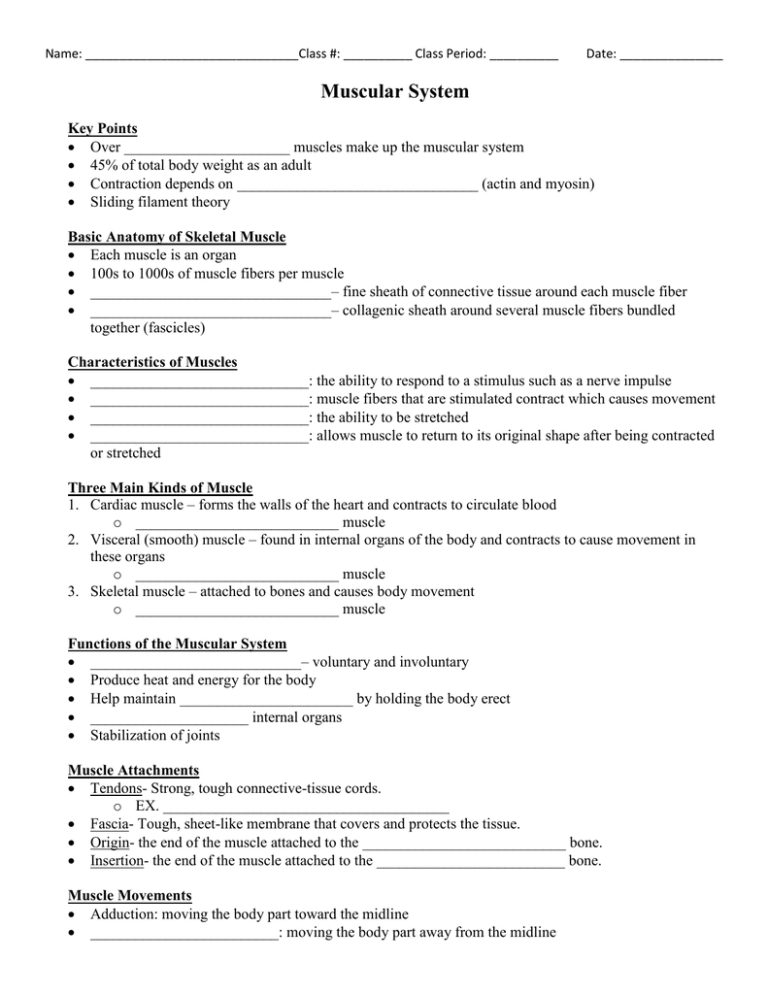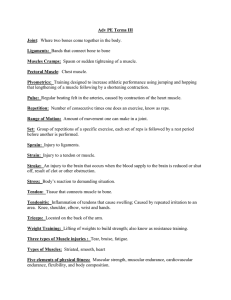Muscular System Notes Sheet
advertisement

Name: _______________________________Class #: __________ Class Period: __________ Date: _______________ Muscular System Key Points Over ______________________ muscles make up the muscular system 45% of total body weight as an adult Contraction depends on ________________________________ (actin and myosin) Sliding filament theory Basic Anatomy of Skeletal Muscle Each muscle is an organ 100s to 1000s of muscle fibers per muscle ________________________________– fine sheath of connective tissue around each muscle fiber ________________________________– collagenic sheath around several muscle fibers bundled together (fascicles) Characteristics of Muscles _____________________________: the ability to respond to a stimulus such as a nerve impulse _____________________________: muscle fibers that are stimulated contract which causes movement _____________________________: the ability to be stretched _____________________________: allows muscle to return to its original shape after being contracted or stretched Three Main Kinds of Muscle 1. Cardiac muscle – forms the walls of the heart and contracts to circulate blood o ___________________________ muscle 2. Visceral (smooth) muscle – found in internal organs of the body and contracts to cause movement in these organs o ___________________________ muscle 3. Skeletal muscle – attached to bones and causes body movement o ___________________________ muscle Functions of the Muscular System ____________________________– voluntary and involuntary Produce heat and energy for the body Help maintain _______________________ by holding the body erect _____________________ internal organs Stabilization of joints Muscle Attachments Tendons- Strong, tough connective-tissue cords. o EX. ______________________________________ Fascia- Tough, sheet-like membrane that covers and protects the tissue. Origin- the end of the muscle attached to the ___________________________ bone. Insertion- the end of the muscle attached to the _________________________ bone. Muscle Movements Adduction: moving the body part toward the midline _________________________: moving the body part away from the midline Name: _______________________________Class #: __________ Class Period: __________ Date: _______________ Flexion: decreasing the angle between two bones, or bending ____________________________: increasing the angle between two bones, or straightening Rotation: turning a body part around its own axis ____________________________: moving in a circle at a joint Muscular Information _______________________________– the state of partial contraction o Muscles are partially contracted even when not in use Atrophy – when muscles shrink in size and lose strength o Due to injury or severe illness ____________________________– a severe tightening of a flexor muscle resulting in bending of a joint Diseases and Abnormal Conditions Fibromyalgia – chronic, widespread pain o Symptoms: muscle stiffness, numbness or tingling in the arms or legs, ________________, sleep disturbances, headaches, and depression o Cause is unknown, but __________________, weather, and poor physical fitness affect the condition o Treatment: directed towards pain relief Myasthenia Gravis o __________________ condition where nerve impulses are not properly transmitted to the muscles o Leads to progressive weakness and eventually ___________________________ o Cause is unknown o Thought to be an ________________________ disease with antibodies attacking the body’s own tissues o No cure __________________________________ o Inflammation of the tendon caused by excessive or repetitive use of a joint. _________________________________ o Muscle tenderness or pain ________________________________ o Rupture of the muscle Muscular Dystrophy o Group of ___________________________ disorders that lead to chronic, progressive muscular atrophy (shrinking, losing strength). o Usually appears in ________________________, most types lead to total disability and early death. o No cure, but physical therapy is used to slow the progression. ________________________ o Injury to a joint (ex. - ankle, knee, wrist). Frequently involves a stretched or torn ligament. o Ligaments attach bone to bone. _______________________ o Injury to the body of a muscle or the attachment of a tendon. Usually associated with overuse injuries. o Tendons attach muscle to bone. Name: _______________________________Class #: __________ Class Period: __________ Date: _______________ _____________________________ o Pain caused by muscle tearing away from the tibia. Usually caused by repeated stress to the lower leg. ______________________________ o Loss of sensation and voluntary muscle movement due to disease or injury. o Damage can be temporary or permanent. _____________________________ o Paralysis of both legs and the lower part of the body. o Spinal cord injury is below cervical vertebrae ______________________________ o Paralysis of all four extremities. o Spinal cord injury involves the cervical vertebrae. o Above C5, respiration is affected. ______________________________ o Total paralysis on one side of the body. Usually associated with stroke or brain injury. o Damage to one side of brain causes paralysis on the ______________________ side of the body.






